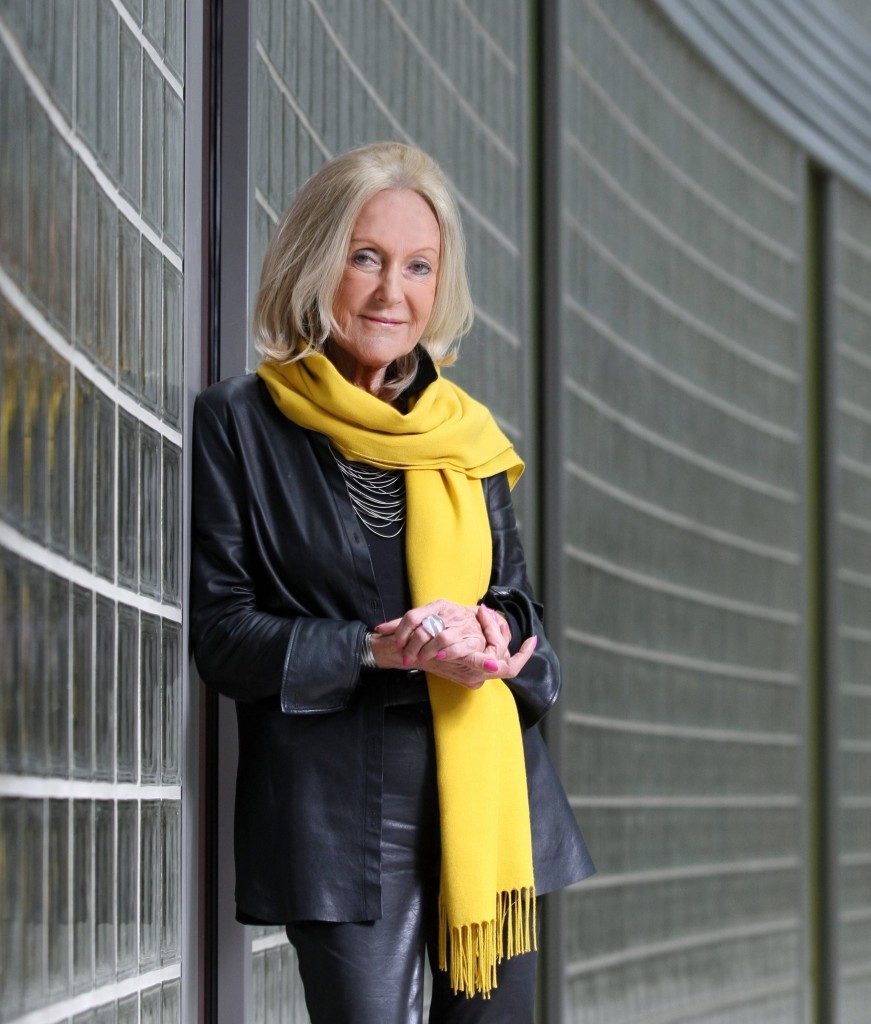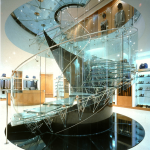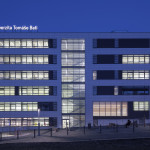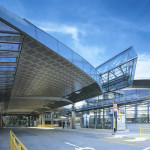The ever upward career steps of Eva Jiřičná
Rereading the words of Eva Jiřičná thirty years later in the long interview given to Alvin Boyarsky enables us to retrospectively grasp the cornerstones of an already successful career. An international success. Countless projects and accomplishments of the artist are spread from New York to Prague, leaving behind an indelible mark on the interior design, revolutionizing the idea of designer stores.
Packed with a slight and tenacious enthusiasm, those pages revive the undecided energy of the beginnings. In a chat in which one can picture her smiling, Eva Jiřičná reminisces those years to Boyarsky – chairman of the prestigious Architectural Association in London who dedicated her a personal exhibition in June 1987.
 The suffocating experience of Socialist Realism – the only officially recognized style – marks her university studies in Prague and inevitably opens that conversation. The vast book collection by her father, who was an architect too, and the rare magazines stuffed in the suitcases of those able to travel abroad – passed from hand to hand among students with keen jealousy – seem only a distant but unforgettable memory. Revealing a limitation of horizon that was nevertheless almost disintegrating, those magazines were ephemeral glimmers of a world that was about to undermine the functionalist group of the Modern Movement to live the first radical and high-tech experiences. The lessons of the critic and theorist Dalibor Veselý, returned from London, sound to young Eva and to the whole generation of designers as “truth revealers”.
The suffocating experience of Socialist Realism – the only officially recognized style – marks her university studies in Prague and inevitably opens that conversation. The vast book collection by her father, who was an architect too, and the rare magazines stuffed in the suitcases of those able to travel abroad – passed from hand to hand among students with keen jealousy – seem only a distant but unforgettable memory. Revealing a limitation of horizon that was nevertheless almost disintegrating, those magazines were ephemeral glimmers of a world that was about to undermine the functionalist group of the Modern Movement to live the first radical and high-tech experiences. The lessons of the critic and theorist Dalibor Veselý, returned from London, sound to young Eva and to the whole generation of designers as “truth revealers”.
Eventually, in August 1968, Eva arrived precisely in this swirling Swinging London, leaving Prague exactly twenty days before the Soviet invasion of Czechoslovakia and not returning home for over twenty years. The exciting London scene of the Sixties with popular Archigram provocations and an insistent run-up to get rid of already faded, monotonous and opaque traditions is extraordinarily varied – especially in the eyes of those coming from beyond the curtain. Beatles and Rolling Stones, Twiggy and Diana Vreeland, Smithson and Reyner Banham fill up the prodigal scene with aspiring ideas and possibilities.
In the overwhelming panorama of London, a talent like Eva’s can only emerge quickly. With uncommon tenacity, Eva replied to over twenty job postings in the Architect’s Journal at the end of her internship at the Greater London Council. The studio of Louis de Soissons – a pupil of Edwin Lutyens – offered her a collaboration on the great Brighton Marina project with David Hodges. Eva mentioned with enthusiasm in several interviews the collaboration that lasted almost a decade throughout which she climbed the entire hierarchy of the team, calling it an extraordinary learning experience.
After leaving Soissons’ studio, a chance encounter offered Eva the life changing opportunity of her career. At a party, she meets Coco, the wife of the London fashion guru Joseph Ettedgui, who had just commissioned a store to Norman Foster. After an initial small interior design work of his apartment, Joseph asks Eva to design the interior of a flat on Sloane Street and simultaneously a store on South Molton Street. The collaboration proved to be a real success. Both extremely meticulous in all details, they would quickly put together dozens of showrooms. The one in Brompton Cross is memorable. Eva has the opportunity to design her first glass staircase, an element to become iconic and distinctive for her creations as much as a real signature. Among her most famous staircases in London, we mention the helical ones of Joan & David store in New Bond Street (1994) and those at Bollinger Jewelry Gallery of the Victoria & Albert Museum (2008). Most recently, we add the one in Tiffany Gallery at the New-York Historical Society Museum & Library (2017), technologically even more daring than the others. One of her first stairways – that of the Kenzo design store made for Joseph – captivates the attention of Richard Rogers who, in 1984, entrusted her with the interior design of one of his most famous London-based projects: the Lloyds headquarters. This assignment established without any doubt the launch of Eva’s career, now destined to a worldwide success.
The following year, Eva engaged in her most famous collaboration with her compatriot Jan Kaplický – exiled in the United Kingdom – for the renovation of the Way-In store within the Harrods department stores. A couple of years later, even Vitra manufactures entrusted her with a few works at their headquarters in Weil am Rhein – the temple of world design.
However, as one can immediately perceive by scrolling through the images of her many creations, Eva’s fame is not limited to interior design projects of dazzling candor. Her unmistakable style that approaches high-tech with unparalleled and refined elegance, sometimes merging with the minimal, finds its application in a great variety of realizations and not only in the United Kingdom. Among the most famous in Czech Republic are the glass and steel tunnel that hosts the Prague Castle Orangery (1998), the Hotel Josef (2002) in Prague with its rational-chic facade and the unique helical and adamantine staircase in the hall, the Tomáš Baťa University Library (2008) in Zlín – her hometown – topped by the most recent Congress Center (2011) whose “thorny” completion hides some technological requirements that would have compromised the roof vision of the valley located building. In this unstoppable march towards the future, the bus stop built by Eva in Brno, in 2011 has a special place. It is an unmistakable homage to the formal and material experiments of Kaplický. The harmonious and sober restoration of the Church of Saint Anne in Prague, Staré Město is highly surprising, now hosting the Centrum Pražská křižovatka. The memory of its fourteenth century vault is entrusted to intertwining thin metal blades above the walls marked by the fascinating patina of time.
Nowadays, at the age of eighty and with a fifty-year long career, Eva Jiřičná prides herself with a multitude of prestigious and academic awards among which stand out the elections at the Royal Academician within the British Royal Academy of Arts and fellow at the American Institute of Architects, the title of Royal Designer for Industry, and Commander of the British Empire, in addition – of course – to the career award granted by the Czech Ministry of Culture.
On the occasion of her 80th birthday, Eva was awarded the City of Zlín Prize for her tireless effort of promoting her hometown in the world and the Dox – Centrum současného umění (The Center for Contemporary Art) in Prague dedicated her a vast retrospective, open to the public until August 12. In addition to designs, original documents and multimedia content, the exhibition includes the helical glass staircase designed by Eva in 1994 for the Joan & David design store.
by Alessandro Canevari








